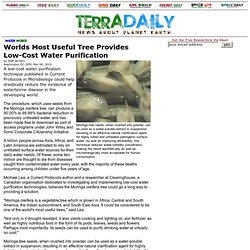

Hydra's Solar-Hydrogen Power Makes Clean Water From Dirty at 20,000 Gallons a Day. For the one in every eight souls around the world lacking access to pure drinking water, how about this: A solar-powered water purification system that spits out pure water, hydrogen and, just for kicks, electricity too.

Could it get any better than that? The device is called Hydra, and like its many-headed mythological namesake it truly serves a multitude of purposes: As its press release notes, "imagine a single trailer-mounted device that turns scum into over 20,000 gallons of pure water a day, stores electricity better than a battery, makes medical-grade oxygen, and runs on the sun. " That's quite enough benefits from one device, thankyouverymuch. It works on a very simple, long-understood principle: electrolysis.
The products are exactly what you may expect: Oxygen to help with medical problems, electricity for any number of purposes, and pure water at a phenomenal rate. But how does Hydra compare with other systems out there that offer some of the same benefits? Bioluminescent trees will replace streetlights? Most people know about light emitting organisms such as jellyfishes, fireflies and mushrooms.

Some time ago, genetic engineers transferred genes responsible for the luciferin and luciferase proteins into a tobacco plant. These firefly proteins were then manufactured by the tobacco plant, causing it to glow and emit light. What if this technology could be extended further to say, a maple tree or a juniper bush? Designer Audrey Richard-Laurent speculates on combining trees and streetlights into bioluminescent trees. In urban areas, one usually sees a row of trees parallel to streetlights. An elegant, yet far fetched idea? Bioluminescence works to replicate processes for creating light found in chemical reactions in the natural world–such as with certain jellyfish or bacteria–for human purposes. See also: Green glowing monkeys, the blogging houseplant. Turn Steel Into Solar Panels With Photovoltaic Spray Paint. No, it's not a joke or a crazy awesome futuristic concept . It's real. Tata Steel Europe (formerly Corus) and Swansea University in Wales, UK are collaborating to develop a spray-on technology that would transform steel sheets into solar panels.
Earth and Industry says , The technology has significant applications since it is highly efficient even in diffused sunlight. Therefore, countries at higher latitudes or those with limited solar energy resource can generate significant amounts of solar-powered electricity with going for large-scale power plants. If extended, the technology can find its way to the automobile industry where photo-sensitive dyes can be applied to cars to generate electricity to split water into hydrogen and oxygen for fuel cells. Imagine the applications of such a product. The power options could be limitless. And if you think the spray-on solar technology is years away from reality, think again. [Photo: Jaredmoo /Flickr] Be The Solution. Worlds Most Useful Tree Provides Low-Cost Water Purification. A low-cost water purification technique published in Current Protocols in Microbiology could help drastically reduce the incidence of waterborne disease in the developing world.

The procedure, which uses seeds from the Moringa oleifera tree, can produce a 90.00% to 99.99% bacterial reduction in previously untreated water, and has been made free to download as part of access programs under John Wiley and Sons' Corporate Citizenship Initiative. A billion people across Asia, Africa, and Latin America are estimated to rely on untreated surface water sources for their daily water needs. Of these, some two million are thought to die from diseases caught from contaminated water every year, with the majority of these deaths occurring among children under five years of age.
"Moringa oleifera is a vegetable tree which is grown in Africa, Central and South America, the Indian subcontinent, and South East Asia. It could be considered to be one of the world's most useful trees," said Lea.